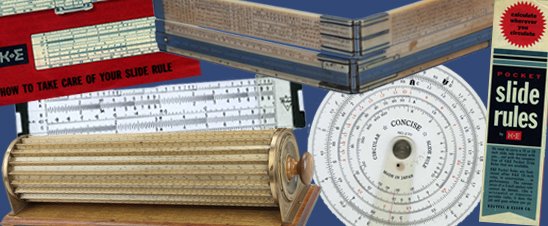This ten-inch aluminum linear slide rule is coated with yellow plastic and has a flat nylon indicator. The back of the base has LL1, LL2, A, D, LL3, and LL4 scales, with B, T, ST, S, K, and C scales on the slide. The left end of the slide is marked: MODEL 14 (/) U.S.
- Description
-
This ten-inch aluminum linear slide rule is coated with yellow plastic and has a flat nylon indicator. The back of the base has LL1, LL2, A, D, LL3, and LL4 scales, with B, T, ST, S, K, and C scales on the slide. The left end of the slide is marked: MODEL 14 (/) U.S. The right end has the Pickett triangular logo used between 1958 and 1962. The style of the grooved stamped aluminum posts is also consisted with this timeframe.
-
The top front of the base has scales for "opposite angle" (sine) in both degrees and mils; the top bottom of the base has "Distance D" and A scales. The front of the slide has scales for apex angle (in both mils and degrees), tangent, sine-tangent, sine, and base. The top center of the base is marked: U.S. MILITARY SLIDE RULE.
-
Pickett & Eckel, Inc., of Chicago and Alhambra, Calif., made this instrument for computations related to the use of field artillery. It fits in an orange-red leather case that has the Pickett logo and US stamped in gold on the front and a metal loop on the back for suspension from a belt. The case is lined with white plastic. A white plastic "data strip" slides into a slot on the case. The strip contains diagrams and equations for trigonometric functions, traverse computations, azimuth and distance from coordinates, triangle computation, and the distance to an artillery target.
-
The case fits in a brown, black, white, and yellow paper box. The box and its insert are repeatedly marked: ALL METAL SLIDE RULE a rule for every need. The Pickett logo appears between the two segments of the mark. The end of the box once bore a paper tag: 1 UNIT - FSN - 7520 - 656 - 0660 (/) Slide Rule – Military, Field Artillery (/) With Data Strip and Case MIL-S-20195B (/) Mfg. Contr.; PICKETT & ECKEL, INC. Model No. 14.
-
The object comes from the Felsenthal Collection of computing devices. (See Felsenthal's company history with 1977.1141.02.) Donor Ben Rau suggested a date of 1965 for this slide rule, but it was probably made a few years earlier. Compare to the box collected with 1995.0126.02.
-
References: Accession File; Tom Bullock, "Pickett 14 U.S. military slide rule," December 8, 2009, http://www.tbullock.com/sliderule.html; Clark McCoy, "Highlights of the A. J. Boardman Collection of Pickett Slide Rules," Journal of the Oughtred Society 16, no. 2 (2007): 10–14.
- Location
-
Currently not on view
- date made
-
1958-1962
- maker
-
Pickett & Eckel, Incorporated
- ID Number
-
1977.1141.29
- catalog number
-
336413
- accession number
-
1977.1141
